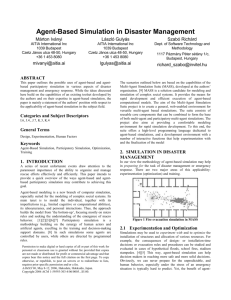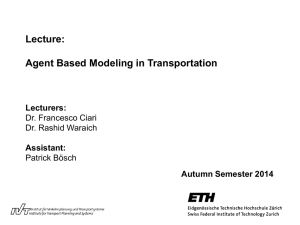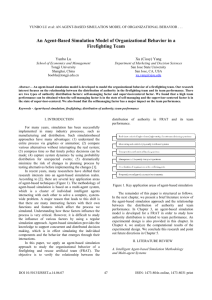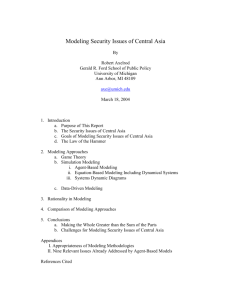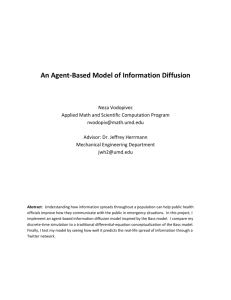Agent based Modeling of Simulation
advertisement
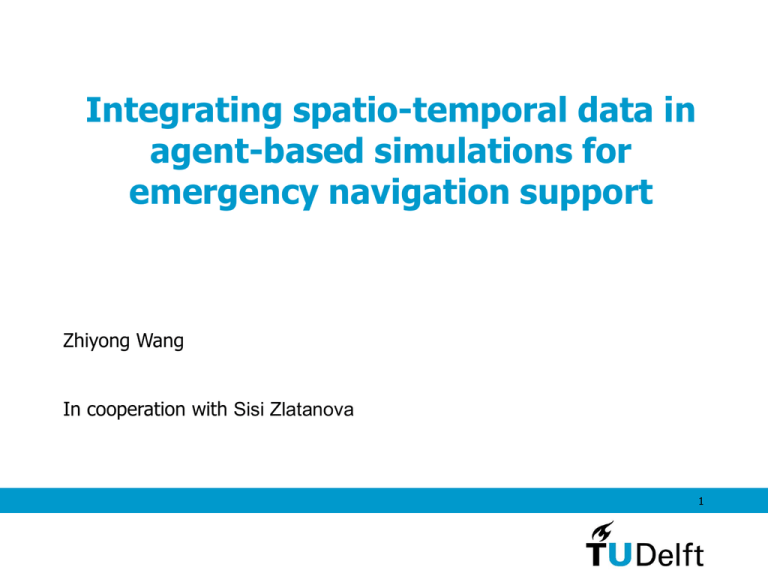
Integrating spatio-temporal data in
agent-based simulations for
emergency navigation support
Zhiyong Wang
In cooperation with Sisi Zlatanova
1
Content
Background
Research question
Research methodology
The prototype system architecture
Use cases
Data and software
Proposed timetable
Planned Publications
2
Disaster management and Emergency
navigation
Pros and cons of GIS tools
Pros
database management
spatial analysis
geographical visualization
……….
Cons
dynamic modelling
simulation
4
Agent based Modeling of Simulation
Agent is:
- a piece of code to describe dynamic phenomena
(moving people, events, plume...)
An agent-based model (ABM) is:
- a class of computational models
- provides simulation of actions and interactions of
autonomous agents (both individual or groups)
The goal is assessing effects on the dynamic system
as a whole (e.g. disaster management, evacuation,
natural phenomena, etc. )
5
Examples of
Agent-based modeling
Predator Prey model
http://www.xjtek.com/anylogic/de
mo_models/11/
Swarm following the leader
http://www.youtube.com/watch?v=f510pma
hpE8
6
Pros and cons of Agent Model simulation
Pros
Complex dynamics
Behavior and interaction between agents
Prediction
……….
Cons
Data used are mostly simulated(no real data)
Predetermined model
7
Integration of GIS and Agent-Based
Model Simulation
Agents and Networks: Commuting Arena Evacuation Simulation in EPT
http://www.youtube.com/watch?v=mvkz1
HwEWXU&feature=socblog_th
http://www.youtube.com/watch?v=ixTi
uLwlLSc&feature=related
Deficiencies of the existing integration of ABM and GIS
Uses lacks real data
Uses real maps and 3D models but hardly real-time
data ( e.g. GPS tracks, plume movement)
Rigid input parameters
Predefined model (No correction)
9
Dynamic Data Driven
Application System (DDDAS)
DDDAS formulates simulation models and methods with:
- dynamically measured data,
- algorithms,
- system tools,
- mathematical and statistical advances
The challenges are:
- how to incorporate additional data
-how to dynamically steer the measurement process?
10
Main Research question
Is integration of spatial data (static such as
2D/3D models and dynamic such as real time
measurements) into agent-based simulations
able to better support the emergency
navigation considering human movements and
moving disasters?
11
The prototype system architecture
12
1. Research questions related to GIS
What kind of information will be needed for agent-based simulation?
How to derive the network from these information
What kind of relationships between agents and spatio-temporal objects
will support the simulation?
What kind of data model should be used for management of the dynamic
data that includes the real-time data, the information of moving objects
(disasters, pedestrian, vehicles, etc.)
13
2. Research questions related to
Agents
How many types of agents should be developed?
What kind of user profile should be considered for route determination
under emergencies?
What kind of rules should be designed for agents to dictate their
behaviors?
How can we evaluate the behaviors of the agents(e.g. rescue vehicle agent,
etc.)?
14
3. Research questions related to
routing
What kind of routing algorithms should be considered?
What kind of re-routing strategy should be designed for the agent to avoid
obstacles and disasters?
How does the agent-based simulation system provide navigation services
for both first responders and citizens?
On what kind of network (2D and 3D) the algorithms will be run?
15
4.Research questions to DDDAS
What kinds of real-time information can be incorporated into the
simulation model?
How to correct the agent-based model with real-time data?
How to verify and validate the developed simulation model?
16
Research Methodology
Literature study and technology requirements
Literature study and technology investigations
Conceptual design
1. Design a multi-agent simulation framework for moving
objects (considering GPS tracks)
2. Extend the multi-agent simulation network by considering
disaster models (considering real measurements)
Implementation
developing prototype
Validation and Adaptation
Conduct tests in different scenarios
Make improvement based on the test results.
17
Use case 1: Agent-based modeling of
human movements during disasters
Jam
Different pattern s of human
movements
Flee
18
Demo 1: updating positions with GPS tracks
During the demo is running you have to explain in when GPS tracks will be used
19
Use case 2: Agent-based approach for
emergence navigation considering the
dynamics of disasters
20
Demo 2: moving plume updated with measurements
obtained from the field
{position, type of geometry, moving speed, direction}
21
Software and Data
Software:
Programing language: Java
Programming tools: Eclipse, Java 3D, Java OpenGL
Visualization tool: Bentley
Agent-based modelling toolkit: REPAST, MASON
DBMS: PostGIS or Oracel Spatial
Data:
available 2D and 3D data
22
Proposed timetable
Year 1
Literature study and technology investigations
Create the agents for modeling the movements of
rescuers corrected with GPS tracking
Make predictions based on mathematical models
Implement the data models for moving objects
Test the prototype system in the road network
Improve the system based on test results
Extend the work into 3D environment
Proposed timetable
Year 2:
Design and implement a multi-agent system
for emergency navigation
Connect the multi-agent simulation model with the
disaster model
Extend the work into 3D environment
Year 3:
Test the agent-based simulation system
in different scenarios
Improve the models of agents.
Year 4
Extend the work considering the disasters and
communication between agents
Assess and improve our systems.
Write the thesis.
Planned publications
Regular reports
2 or 3 conference papers per year
e.g. ISCRAM, AAMAS, DDDAS,UDMS etc.
2 papers in reviewed scientific journals
e.g. Computational Geosciences, Computers and Geosciences,
international journal of emergency response
Thanks for your attention!
Any questions and suggestions?
26



